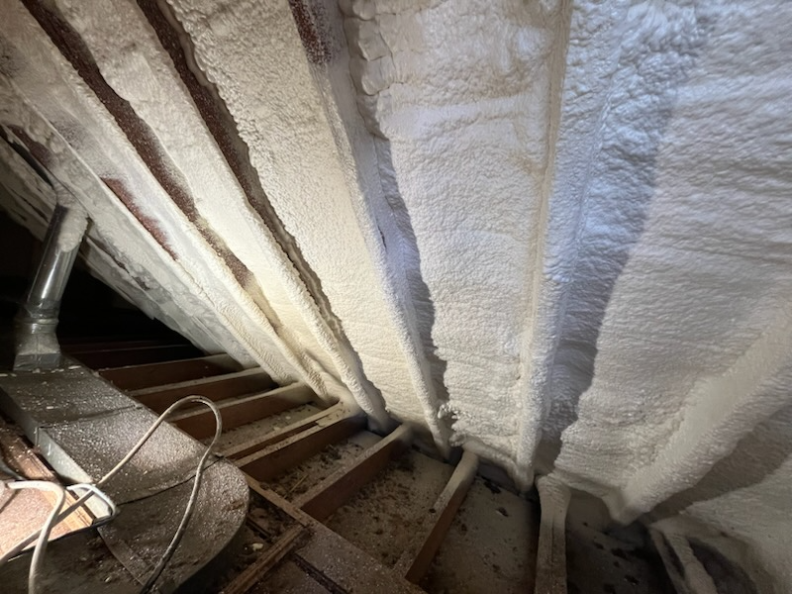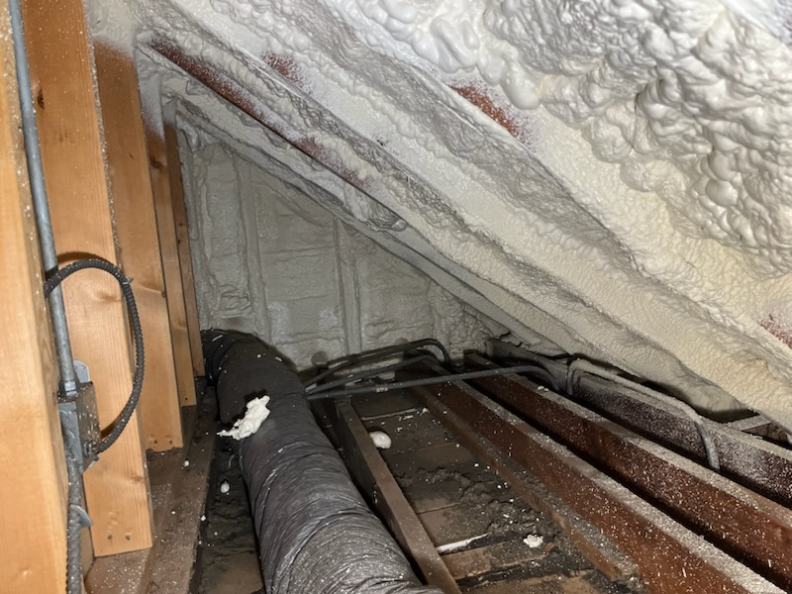
Open-cell spray foam reduces wall air leaks by expanding to fill every crack and gap in wall cavities, creating a tight seal that blocks unwanted airflow. This material starts as a liquid mixture of polyols and isocyanates, which reacts with air to form a foam that grows up to 100 times its original volume. Once cured, it adheres directly to wood framing, drywall, and other surfaces, preventing air from sneaking through small openings like those around electrical boxes or between studs. In practice, this sealing can cut energy loss by up to 50% in some homes, based on field tests from insulation professionals.
This approach stands out because it addresses air leaks at their source, unlike traditional methods that might leave hidden paths open. If you’re in a colder region like the Chicago area, where winter winds amplify the problem, understanding these details can make a big difference in staying warm. The following sections break down the science behind it, compare options, and cover practical steps for homeowners dealing with drafty walls. Information here draws from hands-on work with insulation projects across South Side neighborhoods, where cold snaps highlight the need for solid barriers.
Air leaks in walls happen when builders or time create gaps between materials. Studs in frame walls often have spaces where insulation settles but doesn’t seal completely. Wires, pipes, and outlets punch holes that let conditioned air escape or cold infiltrate. High winds in the Chicago region push air through these spots, raising heating bills and making rooms unevenly comfortable.
Data from the U.S. Department of Energy indicates that air leakage accounts for 25-40% of a home’s energy use. Poor seals force heating systems to work harder, especially during Midwest winters when temperatures drop below freezing. Homeowners notice drafts near windows or baseboards, but hidden leaks in walls contribute most to overall inefficiency.
[Image: Cross-section of a wall showing air paths around studs and how foam fills them]
Open-cell spray foam has an airy structure with pockets that trap air, giving it a lower density than other foams. This design allows it to expand freely and conform to irregular shapes inside walls. It remains semi-flexible after curing, which helps it handle minor settling in older homes without cracking.
The material provides an R-value of about 3.7 per inch, focusing more on air sealing than pure thermal resistance. Installers apply it in layers to match wall thickness, ensuring full coverage. A report from the Building Science Corporation notes that open-cell foam seals air paths 10 times better than fiberglass batts in standard tests.
Before application, check for moisture issues, especially in humid Chicago summers. Open-cell foam absorbs some water vapor, so pair it with proper ventilation to avoid mold risks.
During installation, technicians spray the foam into open wall cavities before drywall goes up. The mixture hits the surface and bubbles up, pushing into every nook. As it hardens, it bonds tightly, eliminating the convective loops (where warm air rises and pulls in cold air, carrying heat away) that allow circulation.
This process stops infiltration (cold air entering) and exfiltration (warm air escaping), the in-and-out flow of air. Studies by Oak Ridge National Laboratory show that homes with spray foam walls reduce air changes per hour by 30-50%, leading to noticeable savings on utility bills. In regional terms, Chicago homes benefit most during heating season, when outdoor air at 20°F tries to invade.
The foam also dampens sound transmission, a side effect from its dense seal. Homeowners report quieter interiors after retrofits, as external noises fade.
Different materials handle air leaks in unique ways. Open-cell spray foam excels at full coverage, but others have roles too.
| Insulation Type | Air Sealing Ability | R-Value per Inch | Cost Range (per sq ft) | Best For |
|---|---|---|---|---|
| Open-Cell Spray Foam | Excellent – fills gaps completely | 3.5-4.0 | $1.00-$1.50 | Drafty walls in cold climates |
| Closed-Cell Spray Foam | Excellent – rigid and waterproof | 6.0-7.0 | $1.50-$2.50 | Wet areas or high moisture |
| Fiberglass Batts | Poor – needs separate sealing | 3.1-4.4 | $0.50-$1.00 | Budget retrofits with added caulk |
| Cellulose Loose-Fill | Fair – settles over time | 3.2-3.8 | $0.80-$1.20 | Attics, not walls |
This table highlights why open-cell fits many wall applications. Market research from the Spray Polyurethane Foam Alliance reports that spray foam installations grew 15% in the Midwest from 2020-2022, driven by energy code updates.

Professionals start by preparing the site, removing old insulation if needed and masking areas to protect. They use a two-component spray gun connected to tanks of chemicals, which mix on-site for immediate expansion. For a typical 2×4 wall, one pass fills to the desired depth.
Curing takes a few hours, after which drywall installs over the foam. In Chicago’s variable weather, crews time jobs for dry days to ensure even application. The process minimizes waste, as the foam sticks where sprayed.
For older homes with knob-and-tube wiring, coordinate with electricians to avoid foam contact that could overheat wires.
Assess home age and construction type first. New builds integrate foam easily, but retrofits might require cutting into walls, adding labor costs. Evaluate R-value needs against local codes; Illinois requires at least R-13 for exterior walls.
Think about indoor air quality. Open-cell foam off-gasses minimally but ensure low-VOC products. Budget for 20-30% higher upfront costs versus batts, offset by long-term savings. The U.S. Energy Information Administration data shows average Midwest households save $200 yearly on heating with better seals.
Regional factors matter too. In snowy Chicago winters, foam’s air barrier pairs well with vapor retarders to control condensation.
Yes. Retrofitting usually involves drilling small holes and injecting the foam into wall cavities. Success depends on how accessible the wall structure is.
While production uses chemicals, once installed it can last for decades without degrading. According to the Insulation Institute, its energy-saving performance reduces the long-term carbon footprint.
It provides minor rigidity by filling voids, but relies on framing for main support. In tests, walls with foam withstand wind loads better than empty cavities.
It absorbs moisture, so avoid basements without dehumidification. In Chicago attics, it works fine with ridge vents.
For a 2,000 sq ft house, expect 1-2 days, depending on wall access and crew size.
It meets basic codes when covered by drywall, but add intumescent coatings for exposed uses.
Choose third-party certified low-emission foams; most cure without ongoing odors.
Open-cell spray foam targets wall air leaks by expanding to seal gaps, cutting energy loss and improving comfort. It outperforms many alternatives in adhesion and coverage, especially in windy Chicago conditions. Weigh factors like cost and moisture before proceeding, and use tests to verify results.
Evaluate specific home needs, local climate demands, and energy goals to decide if this fits. Long-term benefits often justify the investment for draft-free living.
Homeowners seeking to address air leaks can explore options tailored to their property. South Chicago Insulation offers guidance at [email protected] or by calling (779) 803-8025. Discussions focus on practical assessments to match solutions with individual setups, ensuring informed choices without pressure. This step helps clarify how sealing walls aligns with overall comfort and savings goals. (78 words)